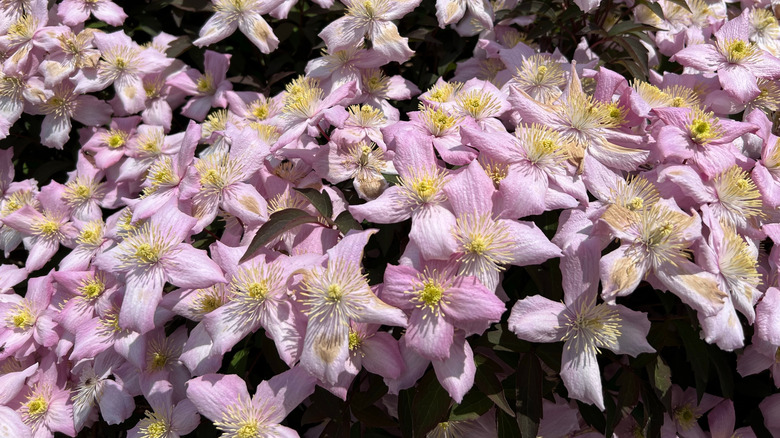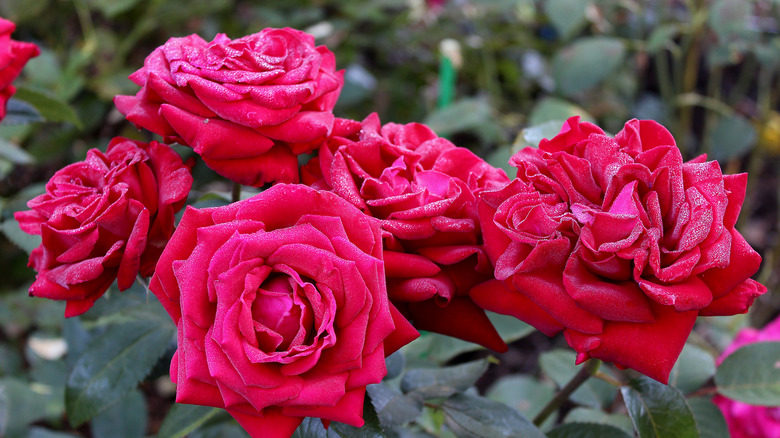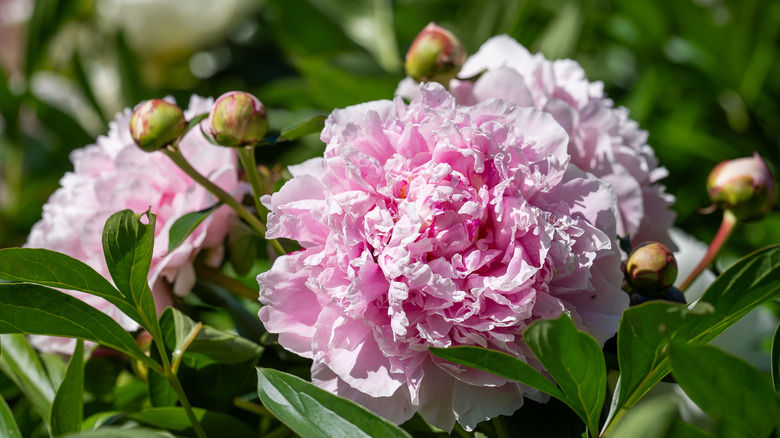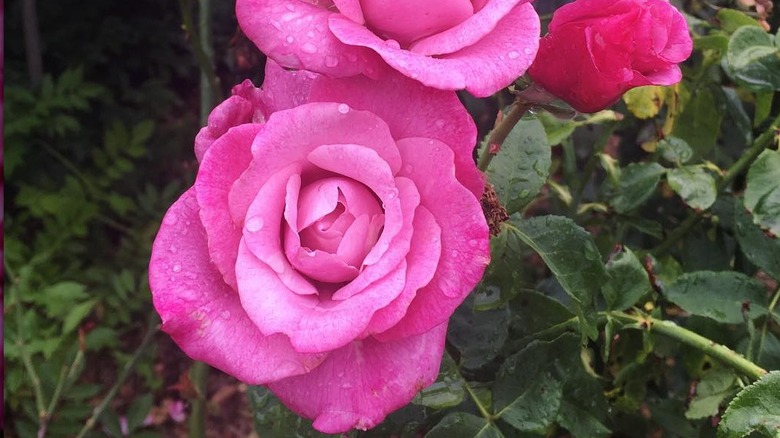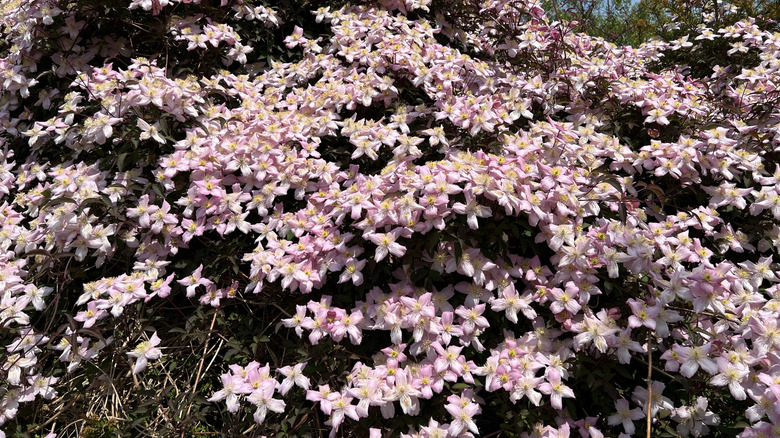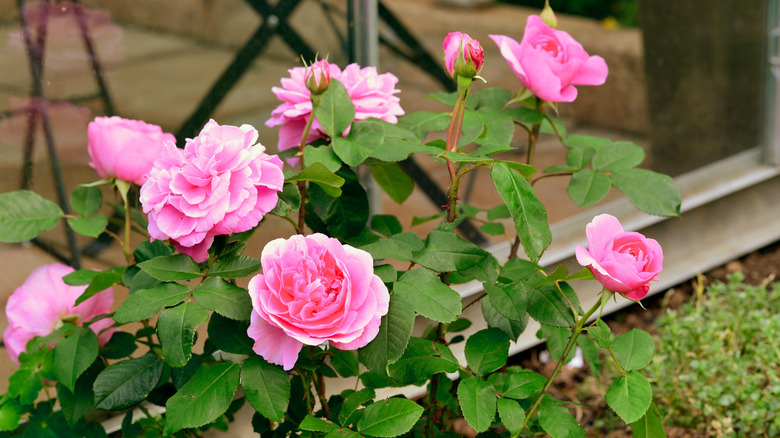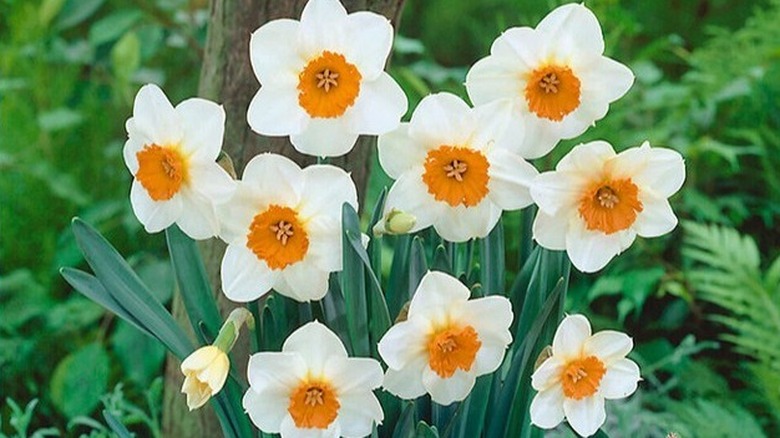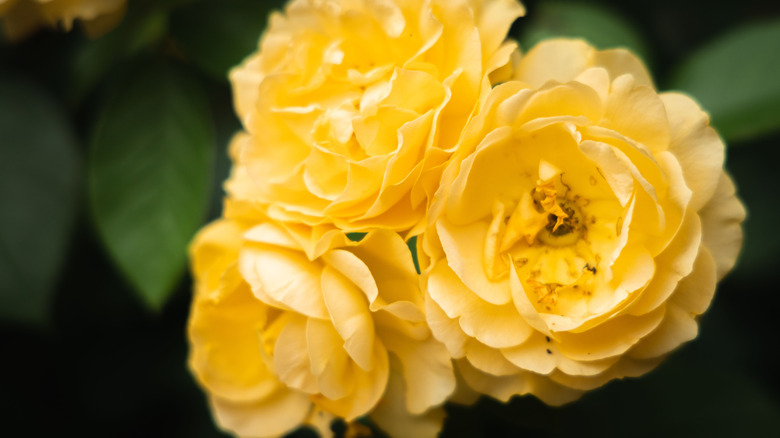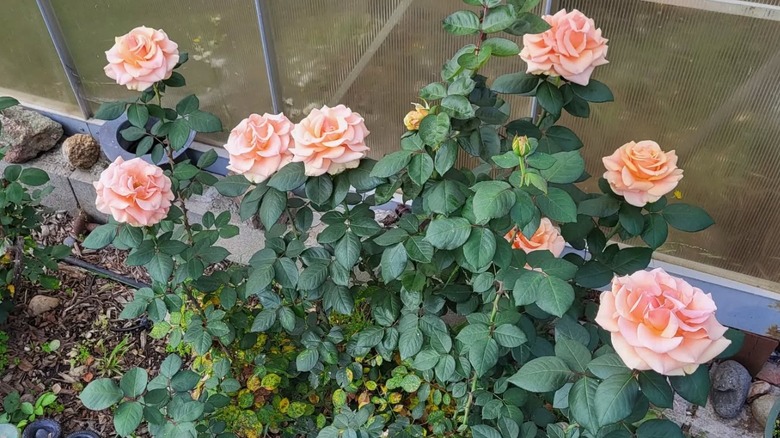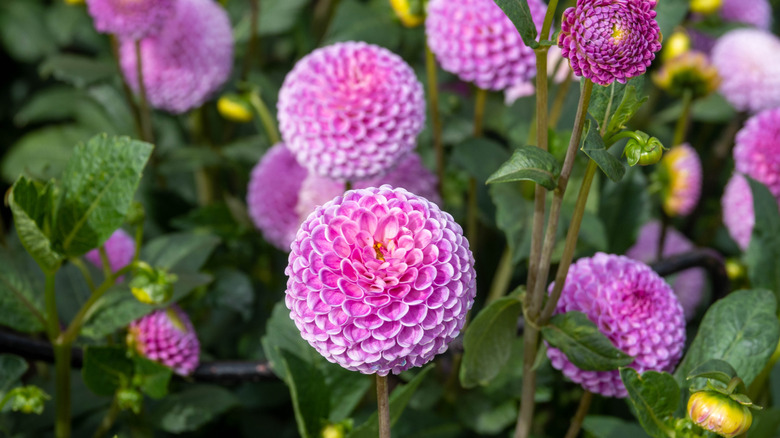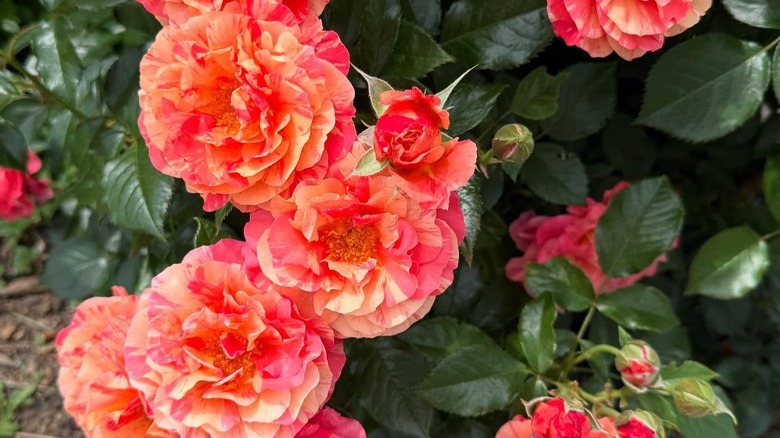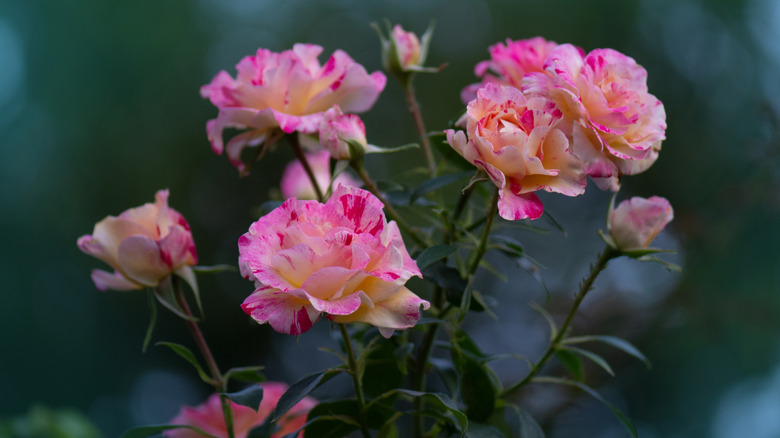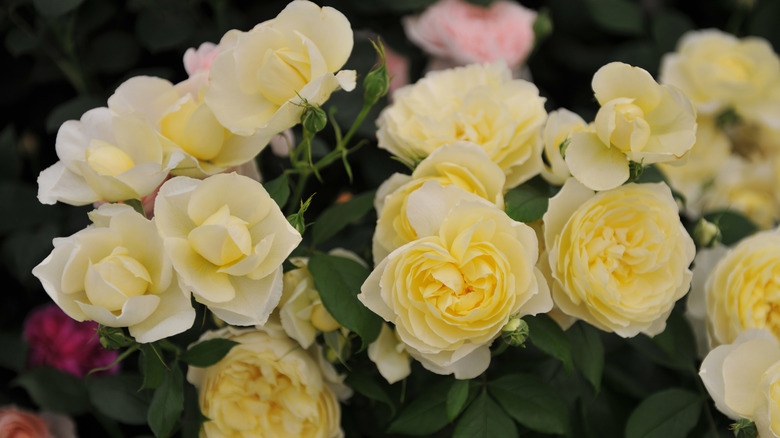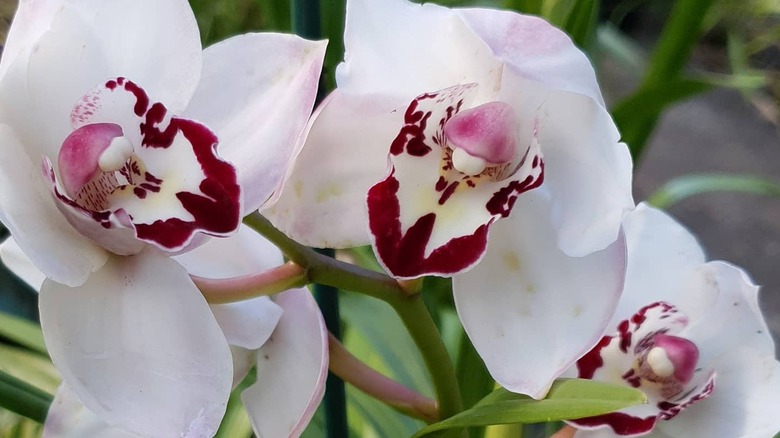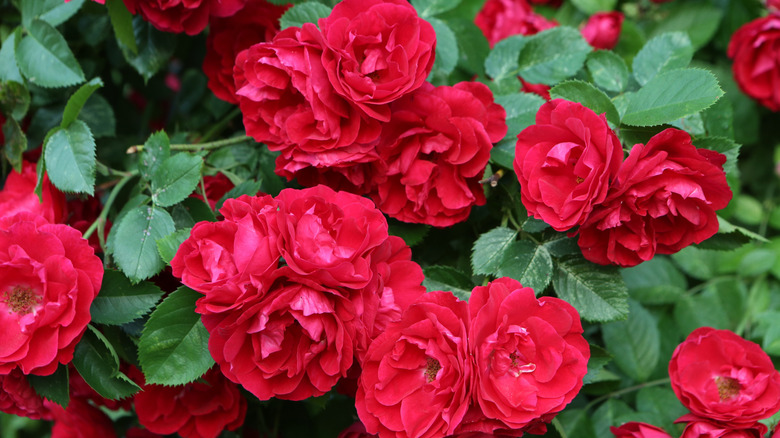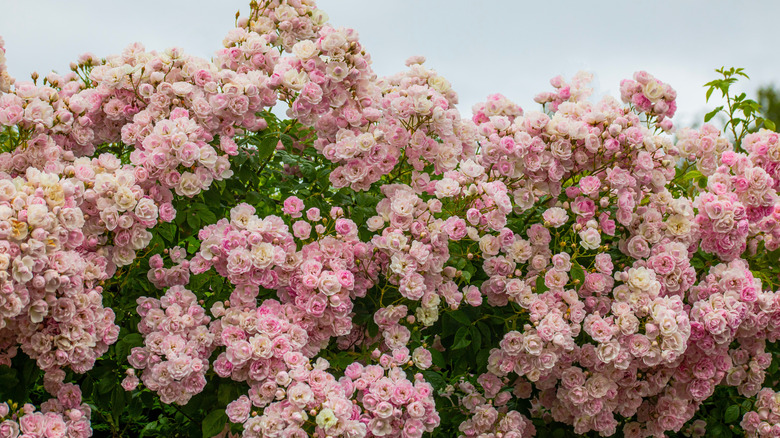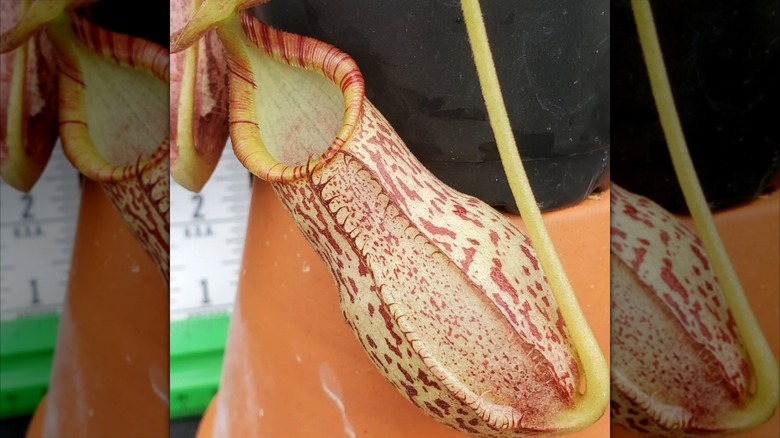16 Stunning Flowers You Didn't Know Were Named After Celebrities
Those steeped too deep into the gardening world may have chanced upon the latest introduction from the Royal Horticultural Society: 'Catherine's Rose.' This coral-pink flower was specifically developed — and so named after Kate Middleton — with the sale proceeds set to support cancer patients. While 'Catherine's Rose' isn't available to U.S. citizens, it set us on the path to discover other flowers that were christened after famous personalities and are readily available. Unsurprisingly, we were not disappointed, and hopefully, neither will you be as you peruse through the selection.
Knowing how popular roses are across the U.S. gardens, it shouldn't be surprising that most flowers flaunting celeb names are roses. From Ingrid Bergman and Barbra Streisand to Frida Kahlo and Julia Child, these offerings span movie stars, chefs, and artists — some orchids, peonies, and dahlias, too, sport celebrity names. Although many of these flowers were personally chosen by the stars themselves, plenty of others were labeled so by their breeders, either in their honor or to generate buzz about rare species. Irrespective of their baptism, they're all absolute stunners, as you'll discover.
Ingrid Bergman Rose
Debuted in Denmark to honor the acclaimed Swedish actress, the Ingrid Bergman rose (Rosa 'Poulman') similarly earned acclaim in 2000 from the World Federation of Rose Societies. It features velvety, perfectly formed, lusciously red blooms that appear in repeat flushes from spring through frost, infusing the landscape with a light fragrance. These hybrid tea roses require full sun exposure in USDA Hardiness Zones 4b and south and look their best when massed. Alternatively, pot them up, but make sure to overwinter them indoors to avoid cold damage. Disease-resistant, these roses can grow nearly 3 feet tall.
Sarah Bernhardt peony
Sarah Bernhardt peony (Paeonia lactiflora 'Sarah Bernhardt') is coined after a popular 19th-century French stage actress. Around mid-spring, the herbaceous mound explodes a mass of pale pink blooms that eerily resemble cherry blossoms but obviously aren't. The 3-foot-tall shrub remains attractive until frost kills its foliage; it remains cold hardy to zone 3. You may clip peonies for your vases or leave them in the borders where their heady fragrance can be enjoyed. They're also suitable as living hedges to deter deer or as accents highlighting walkways.
Barbra Streisand rose
Are you looking for rose varieties that will make your garden smell heavenly? So was American singer Barbra Streisand when she was picking roses that would sport her name. Botanically called Rosa Barbra Streisand 'WEKquaneze,' these citrus-smelling hybrid tea roses produce double, lavender blooms with dark margins in spring, with multiple flushes expected up to fall in zones 5 through 9. Mass them in cottage, cutting, or pollinator gardens where butterflies can sip their nectar. Since these nearly 5-foot-tall rose shrubs have a dense habit, you can use them for privacy or a hedge. Monitor their growth for spring damage, deer browsing, and blackspot.
Clematis 'Elizabeth'
Named so to honor Queen Elizabeth II, her namesake clematis vine (Clematis montana 'Elizabeth') is an award-winning deciduous climbing plant, hardy in zones 6 through 9. So vigorously does it bloom that the foliage barely shows through the satiny mauve-pink flowers displayed during spring and summer. Where sufficient support is available, 'Elizabeth' can scale over 35 feet, extending 15 feet across. Hummingbirds, butterflies, and beneficial insects visit these vines, though deer do not (luckily!). Give them ample sun exposure and moist, well-draining soils. As they're heat- and drought-resistant, they can be suitably grown in hot sites. Note that they're harmful to furry friends.
Gertrude Jekyll rose
David Austin's brainchild, Gertrude Jekyll rose (Rosa Gertrude Jekyll 'AUSboard'), was named so to honor their namesake's outsized influence on garden design — a fact experienced gardeners are probably privy to. A quintessentially English rose, Gertrude Jekyll can be trained as a climbing plant, perfect for a north-facing wall or a fence, given its tolerance for moderate shade. Winter hardy through zone 4 and south, these rose shrubs will beguile you with the prettiest pink rosettes through three seasons. They can grow over 6 feet tall and half as wide and be used to frame walkways or patios.
Small-cupped daffodil 'Barrett Browning'
"How do I love thee?" Surely, this love sonnet from Elizabeth Barrett Browning rings a bell. So influential has been her impact that a hybridized small-cupped daffodil was named after her. Botanically known as Narcissus 'Barrett Browning,' has been a garden beloved since the 1950s, with onlookers rejoicing in the orange-cupped white flowers dancing atop their green stems, mid-spring. It has also won "The John and Gertrude Wister Award" from the American Daffodil Society in 2011. Site these deer-resistant bulbs in a sunny, well-draining spot where they can naturalize — zones 3 through 9. They're toxic on consumption and irritate the skin.
Julia Child rose
Not only did Julia Child make French cuisine approachable to the U.S. audience, but she also personally picked a butterfly yellow rose to assume her name. Embodying licorice-clove aroma, Julia Child roses (Rosa Julia Child 'WEKvossutono') star elegant, ruffled petals that may fade into pale whites by the end of the growth season. Since they've got a long growth season (sometimes lasting as late as November), they're popularly planted in garden beds and containers. They perform well in zones 5 through 10, though you must watch for deer. Deadheading, spring pruning, and regular fertilization are important for plant vigor.
Marilyn Monroe rose
Named after the notable 1950s Hollywood star, Marilyn Monroe roses (Rosa 'WEKsunspat') are just as stylish and captivating as her. Produced by Tom Carruth, this hybrid tea variety shows hints of apricot from buds through petals and remains in continual bloom throughout the warm season. Hardy in zones 6 and south, these roses are perfect for a cut flower garden, given their exceptional shelf life and pleasant citrusy fragrance. The plant grows vigorously, reaching heights of over 5 feet and widths of 4 feet. It is disease- and heat-resistant, but be mindful of thorns.
Pompon dahlias
You might not know this, but pompon dahlias have another name to their acclaim: Dahlia 'Franz Kafka.' Called so to honor the existential Czech writer, pompom dahlias, in contrast, inspire much joy among onlookers. Their lollipop-shaped pink flowers remain in nonstop bloom from mid-summer until frost, attracting butterflies. They require full sun exposure in zones 8 to 11, though afternoon shade is much appreciated during summer extremes. Plant them in drifts of five in beds and borders to maximize impact. However, keep furry friends away from these compact plants as they can be toxic on accidental consumption.
Frida Kahlo rose
Maybe you did connect the dots on this one, but considering how influential Frida Kahlo has been for art, it would be a shame not to mention the equally artful floribunda roses bearing her name. Scientifically called Rosa Frida Kahlo 'WEKcifrabaun,' these fruity-smelling shrubs attract butterflies and bees by the dozens with their gold-stripped, coral-red flowers that only deepen in color, turning a blushed red as the summer transitions into fall. Tolerating full-to-part sun exposure, they perform well in zones 5 through 10. Group the prickly shrubs as mini hedges or use them as accents in foundation beds.
Claude Monet rose
The painter obsessed with water lilies also has roses named after him, and an absolute beauty they are. Hybridized by Jack E. Christensen, Claude Monet roses (Rosa 'Jacdesa') are a hybrid tea rose variety emanating a vanilla fragrance with fruity undertones. Appearing as a mass of pink roses that've been accidentally painted over in yellow, they're sure to entice you as well as your yard's bees with their repeat flushes from spring to fall. They're hardy only up to zone 6, enjoy full sun, and these plants must be pruned in spring to keep them happy and healthy.
Vanessa Bell rose
Virginia Woolf's painter sister and the founder of the Bloomsbury group, Vanessa Bell, has a David Austin shrub rose named after her, although its botanical name is Rosa 'Auseasel.' Pink-blushed buds unfurl creamed buttery yellow petals that fade around their edges as they age. Planted in hedges, borders, or pots, they'll leave you feeling cozy with their green tea-like aroma that often carries honey-lemon undernotes. For a change, this yellow-flowering beauty is unfussy, tolerating all kinds of soils. While full sun exposure is recommended, moderate shade works, too, in zones 5 through 11.
Cymbidium Vanessa Amorosi
Vanessa Amorosi is an Australian songwriter after whom Royale Orch decided to name a hybrid orchard variety in 2001. Fast forward, Cymbidium Vanessa Amorosi is considered one of the easiest orchids to grow today. Outdoors, it can withstand temperature dips to 30 degrees Fahrenheit. Otherwise, you can keep it as a houseplant in diffused light with orchid bark or coconut husk as its substrate. Expect white-pink flowers in the fall, emitting a fruity fragrance — as one can expect from a recently cut watermelon — atop pendulous stalks.
'Amadeus' rose
Apart from the 'Mozart' hybrid musk rose, the legendary music composer has another rose variety to his name: 'Amadeus' rose (Rosa 'Korlabriax'), with Amadeus standing in as a Latinized version of his true middle name, Theophilus. A multiple award winner, this climbing rose stars clusters of mildly fragrant, fiery red roses that bloom in repeat flushes throughout the growth season — especially if you keep removing spent blooms. 'Amadeus' is hardy in zones 6 through 10 and is highly resistant to mildew and blackspot. It can grow nearly 4 feet wide and be trained over a fence or a pillar.
James Galway rose
When parsing through nursery catalogs for pink rose varieties to make a blushing garden, you may have come across David Austin's James Galway rose (Rosa 'Auscrystal'). Since it's so easy to get lost in your admiration for the ruffled pink blossoms, you might have failed to notice that these shrub roses — or climbers if you wish to train them so over walls and arches — are named after the famous "The Man with the Golden Flute," James Galway. They're at home in zones 4 through 9 and tolerate moderate shade. They're also disease-resistant and relatively thornless.
Nepenthes 'Helen'
Are the birds in your yard doing a poor job of pest control? Or, maybe you're itching to grow some truly unique plants while still name-dropping a celeb? Consider Nepenthes 'Helen' (Nepenthes spathulata x spectabilis 'Helen' BE 4528), a carnivorous jungle plant that owes its name to Helen Mirren, the actress who portrayed Queen Elizabeth II in 'The Queen.' Introduced by Bergen Water Gardens, 'Helen' sports striking stripes across its pitcher shape. Any partially shaded area, where temperatures don't drop below 50 degrees Fahrenheit, such as a windowsill or a terrarium, would suffice. Mist them regularly, as they prefer humid conditions.
